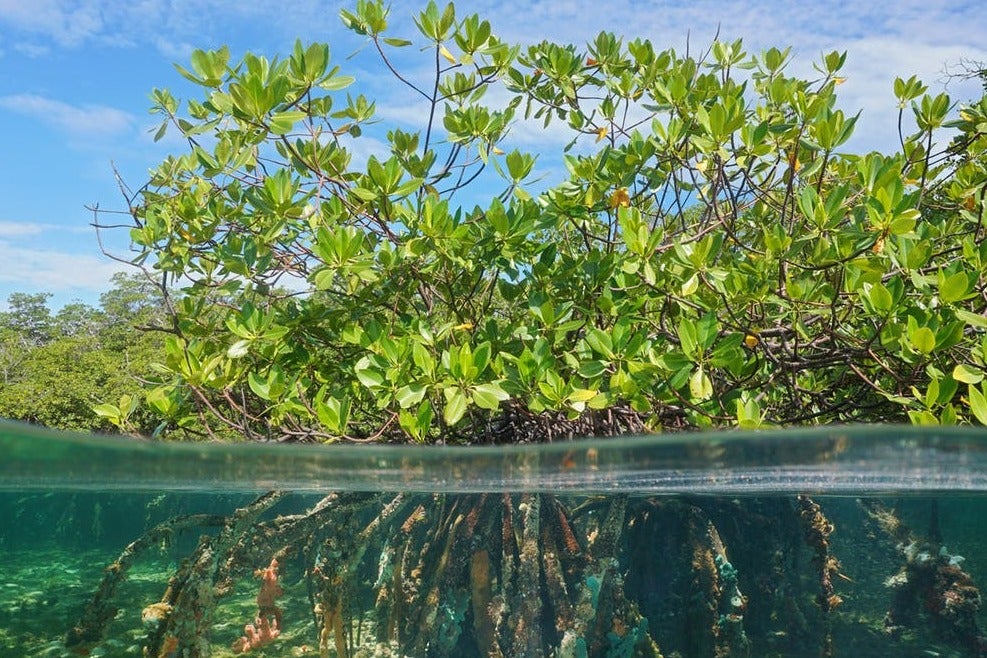Mangrove forests thrive in a warming climate – and we should embrace this
The plants protect coastlines, treat polluted waters, provide livelihoods for some of the world’s poorest people – and could be a huge asset in mitigating climate change

Humans have become adept at destroying natural habitats. Indeed, we’re so good at it we’ve changed the very makeup and climate of our planet. But there may be signs the natural world is fighting back by protecting itself against rising temperatures and changing weather patterns – and we face the tantalising prospect of helping this process.
A recent study found that mangrove forests could be adapting to climate change by growing beyond their usual range. The risk of several days of continuous frost, which previously kept these trees in tropical and subtropical areas near the equator, is continuously shifting towards the poles. As average global temperatures rise, mangroves are able to expand their range beyond the equator.
Mangrove forests are coastal wetlands made up of a dense jumble of trees and shrubs capable of living in salt or brackish water. Known by their tangle of roots sticking out of the ground, mangrove forests can grow out into the sea and create almost impenetrable mazes of narrow channels along shorelines.
Mangroves protect coastlines, treat polluted waters, provide livelihoods and resources for some of the world’s poorest people and are home to an impressive number of species – many of which are commercially important. It’s been suggested that the majority of the global fish catch relies, either directly or indirectly, on mangroves.
But humans have done an impressive job over the last century of destroying them to make way for coastal developments and aquaculture, and by logging them for timber and fuel production. Not to mention destroying their natural water courses and polluting the ground they grow in.
So the possibility that climate change could be helping these habitats is promising indeed. In the long run, this could help society adapt to climate change and even reduce the concentration of greenhouse gases in the atmosphere.
Adapting to climate change
One feature of mangroves that we’ve long benefited from is coastal protection – typhoons, hurricanes and tsunamis lose their power passing through them.
Their mass of roots – both above and below ground – help to bind and build sediments, meaning mangrove areas can grow vertically, which is a clear asset in the face of rising sea levels. Expanding mangrove forests could therefore help protect us from the devastating effects of extreme weather that become more likely with climate change.
Mangrove forests are also incredibly productive ecosystems, which means that lots of carbon dioxide is taken in and used by the trees and shrubs as they grow. When this organic matter dies, a proportion of it forms the sediment underneath the mangrove forest. As a result, carbon remains trapped as semi-decomposed plant matter, and is unable to re-enter the atmosphere as a greenhouse gas. This ensures mangroves can act as giant stores – or sinks – of carbon.
Research suggests that mangroves could be better carbon stores than the coastal habitats they are encroaching on – meaning they could combat the very causes of global warming.
Around the world, some mangrove forests are being given legal protection. Large-scale restoration works are taking place with varying degrees of success, as one study in Sri Lanka found.
In America and Australia, areas of mangrove dieback are being restored after ill-considered developments and the use of herbicides. Conservationists and academics are researching where mangrove restoration would be most beneficial, and developing the best methods for these projects around the world.

The knowledge that mangroves could both benefit from a changing climate and protect us from some of its worst effects demands a renewed vigour in promoting these wetlands. It also raises a question. Should resources be ploughed into maintaining ecosystems where regional climate changes could undo the hard work? Or should we concentrate our efforts on helping expand habitats that are not only resilient to climate change but can help mitigate climate change itself?
Perhaps it is time to move towards the latter and act as ecosystem physicians, giving healing and healable habitats such as mangroves every opportunity to do what they do best.
Christian Dunn is a lecturer in wetland science at Bangor University. This article first appeared on The Conversation (theconversation.com)
Join our commenting forum
Join thought-provoking conversations, follow other Independent readers and see their replies
Comments
Bookmark popover
Removed from bookmarks